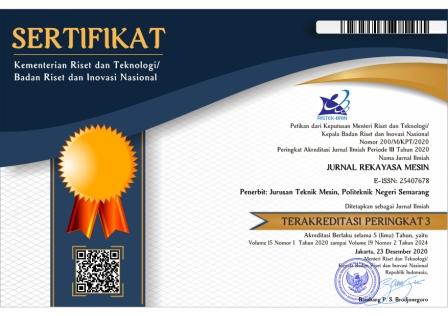Analisa Kekentalan Biodiesel Dan Uji Unjuk Kerja Di Mesin Diesel
DOI:
https://doi.org/10.32497/rm.v8i2.399Keywords:
“nyamplung”, ”transesterifikasi”, “biodiesel”, ”kekentalan”, “efisiensi”Abstract
Penelitian dilakukan dengan memfokuskan pada biodiesel nyamplung. Pembuatan biodiesel dengan metode transesterifikasi alkali. Selanjutnya uji karakteristik biodiesel diarahkan pada uji kekentalan untuk menentukan tingkat kestabilan. Uji unjuk kerja dilakukan di engine test yang pada prinsipnya terdiri dari mesin diesel satu silinder, generator, transmisi dan beberapa alat ukur. Hasil uji karakteristik kekentalan menunjukkan bahwa kekentalan biodiesel nyamplung cenderung berubah dan mencapai 12,06 mm2/s. Selanjutnya uji unjuk kerja menunjukkan bahwa konsumsi bahan bakar spesifik dengan bahan bakar biodiesel cenderung mempunyai kesamaan dengan konsumsi bahan bakar spesifik dengan bahan bakar solar. Dan pengujian bahan bakar di engine test menunjukkan bahwa bahan bakar biodiesel nyamplung B10 menghasilkan efisiensi yang baik pada beban 1.000 watt hingga 2000 watt.
Kata kunci: “nyamplung”,”transesterifikasi”, “biodiesel”,”kekentalan”, “efisiensi”Downloads
Published
How to Cite
Issue
Section
License
Copyright of articles that appear in Jurnal Rekayasa Mesin belongs exclusively to Penerbit Jurusan Teknik Mesin Politeknik Negeri Semarang. This copyright covers the rights to reproduce the article, including reprints, electronic reproductions, or any other reproductions of similar nature.






